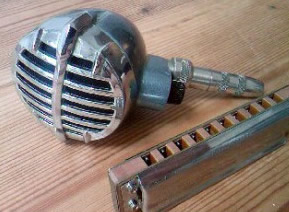Beefing Up Those Bends – 4 Draw Bend
 Here’s a simple two-part exercise to help strengthen your 4 draw bend. We’ll assume you have already found your draw bend, but haven’t perfected playing it in isolation without scooping down from the clean draw. If you have already perfected them, you may still find this exercise useful in sustaining your bending muscles and add it to you ‘harp gym’ regime. Hitting a bend accurately and without scooping is known as direct bending – a skill which is central to controlled playing. If you haven’t yet attempted any bends, why not take a look at the draw bend page from my Harp Skills menu here.
Here’s a simple two-part exercise to help strengthen your 4 draw bend. We’ll assume you have already found your draw bend, but haven’t perfected playing it in isolation without scooping down from the clean draw. If you have already perfected them, you may still find this exercise useful in sustaining your bending muscles and add it to you ‘harp gym’ regime. Hitting a bend accurately and without scooping is known as direct bending – a skill which is central to controlled playing. If you haven’t yet attempted any bends, why not take a look at the draw bend page from my Harp Skills menu here.
Stage One
We start by moving from the draw note down to the draw bend as slowly as possible. The objectives are to maintain a good tone (no loose air), a respectable amount of volume and to control the descent. Now do this again, but saving enough lung capacity to hold the bend as long as possible. Remember to descend as slowly as possible first.
Now let’s extend the exercise by moving slowly down to the bend, holding the bend without wavering and then releasing the bend by degree (slowly) back to the clean draw. Don’t worry if this last part is harder than the descent, that’s normal. Keep working at it, building control as you go.
The more slowly you do this exercsie, the more control you will develop, together with improved muscle memory for direct bending. You are effectively imprinting the required positioning into your chops, jaw and vocal tract muscles.
Stage Two
Simply learn to transfer from the draw note to the draw bend, then to the blow note and back again, sounding each note individually without any scooping, before finishing back at the straight draw. The tab looks like this:
4D 4D’ 4B 4D’ 4D
Initially the difficult part is returning from the blow note to the draw bend without relying on an interim scoop down. You need to direct bend using all your newly acquired control. If this doesn’t happen at first, don’t despair. Go back to stage one and get those muscles educated. Then try stage two again. Once you have cracked the process, why not repeat it in holes 1 and 6 and get used to the different character of the reeds.
